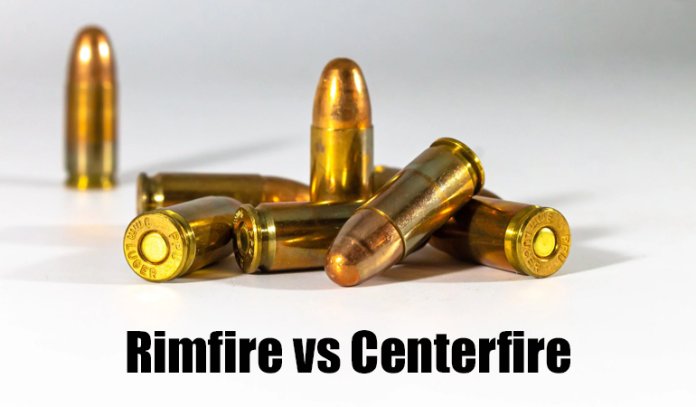The above terms have been at the center of debates about firearms. Whether you are new in this space or are experienced and only want to refresh your knowledge of ammunitions, understanding the factors that set different ammo apart could enhance your shooting experience.
As you head out to the local range, you are more likely to shoot with more confidence if you know what your armory entails. Shooting applications vary all the time and being able to figure out which ammo to use each time might greatly determine the effectiveness of your firearm.
Contents
- What Does Ammo Cartridge Mean?
- A Cartridge’s Components Explained
- How Does the Ammunition Get Fired?
- How Does Rimfire Differ From Centerfire?
- So, How Do You Visually Distinguish a Centerfire From a Rimfire Round?
- What are the Variations Of the Centerfire Cartridge?
- Where is the Rimfire Ammunition Commonly Applied?
- Which One is the Better Ammunition For You?
- Recommended or Not?
- Rimfire vs Centerfire – Final Verdict
With this entry, I intend to expand your knowledge of firearms with a particular mission of helping you understand what makes Rimfire vs Centerfire ammo different.
So, what are they? Where are they best applied? How are they used? What are the pros and cons of using each? Which is better and why?
Come along as we explore this interesting ammo world and get armed with the right information before loading your weapon with the next round.
What Does Ammo Cartridge Mean?
Whether you are target-shooting using rimfire or centerfire ammunition, the popular phrase describing this action at the range is simply “firing a round of ammunition”. In most cases, the statement is likely to confuse a beginner with many generalizations storming their mind. An experienced shooter, however, will easily get the hang of it.
The more you learn about firearms, the easier it gets for you to explain your weapon’s features or applications. If you’re new to firearms, for instance, you’ll probably not know that a round of ammo is just a cartridge in firearm dialect. Simply described using parts, a cartridge comprises the casing, primer, propellant (or gunpowder), and projectile (or bullet). The mistake most shooters (even experienced ones) make is bundling all these parts and calling them a “bullet”, yet this is just a part inside a cartridge.
All the bullet does is terminate the firing process once the other parts initiate the process in a functionally coordinated sequence.
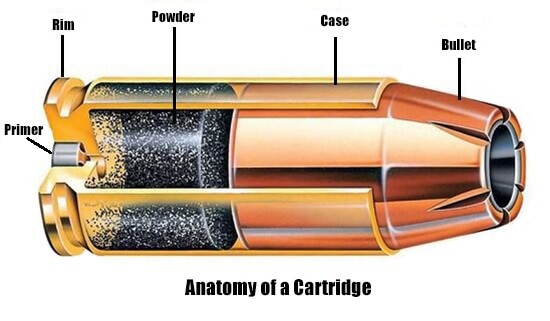
A Cartridge’s Components Explained
So, how well do you know your cartridge? Now that you know it comprises several other parts besides the bullet, let’s review what constitutes it.
- Case: The case is the outer container or compartment responsible for housing all the other components of a cartridge. In most cases, the case is made from copper, brass, or steel.
- Primer: This refers to a special chemical compound bearing explosive capabilities. It is responsible for igniting the gunpowder or propellant when hit by the firing pin. The primer may be situated either inside the cartridge base center (centerfire) or in the cartridge base rim (rimfire).
- Propellant or gunpowder: This comprises a powdered mixture that is combustible. Upon ignition, the powder burns vigorously before expanding as it changes into a gas. That expansion creates a strong force that drives the bullet out.
- Projectile or bullet: This is the tip of the cartridge. It is the emission extracted from the gun’s barrel whenever you take a shot.
How Does the Ammunition Get Fired?
Having painted a vivid picture of your typical ammunition, the next step is learning what transpires after taking a shot. This knowledge will lay a solid groundwork from which you could draw facts when you finally soak into the discussion seeking to distinguish rimfire from centerfire rounds.
This process flows sequentially:
- All you need to do is position your firearm accordingly.
- Put your cartridge, whether you’re using rimfire or centerfire, in a designated chamber.
- Close the chamber and retract the firing pin against spring tension.
So, what does pressing your firearm’s trigger does?
Well, it sets the firing pin in motion. As the pin advances with immense force, it hits and creates a spark in the primer, which is sitting at the base of a cartridge. The spark that the primer produces is enough to set ablaze the gunpowder, thus giving rise to massive gas pressure.

The gas expansion yields enormous pressure thrusting the bullet forward (detaching from the cartridge head) and forcing it to exit the gun barrel. The resulting “bang” sound is a function of the bullet’s super-speed and the corresponding runaway gases.
How Does Rimfire Differ From Centerfire?
Before delving into the broader differences, it is worth noting that the identity of both these ammunitions stems from the functionality of their primers (i.e. how they are ignited).
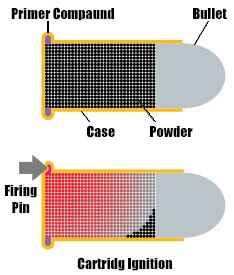 That means when shooting using a rimfire round, the gun’s firing pin acts directly on the cartridge’s bottom rim to activate the primer. In the case of using a centerfire round, the gun’s firing pin hits a centrally-situated primer directly to launch ignition.
That means when shooting using a rimfire round, the gun’s firing pin acts directly on the cartridge’s bottom rim to activate the primer. In the case of using a centerfire round, the gun’s firing pin hits a centrally-situated primer directly to launch ignition.
From this analysis, it is clear that the key underlying difference between the two rounds lies in the location of the primer. Otherwise, everything else remains unchanged for both. This is particularly true for the shooting process and the cartridge components.
The image demonstrates how the gun’s firing pin acts on the base of the cartridge as explained in the above processes.
So, How Do You Visually Distinguish a Centerfire From a Rimfire Round?
The appearance of both ammunitions is rather distinctive making it a breeze to tell them apart. Here is a pro tip:
if the cartridge features a ring-shaped primer at the center of the casing’s base, then you have centerfire ammunition.
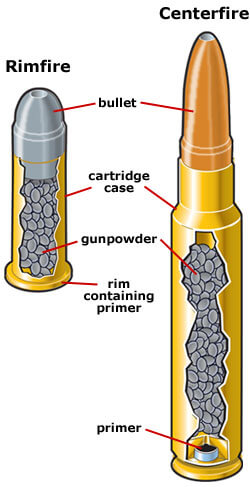 If on the other hand, you are dealing with a tinier cartridge with no apparent primer distinction on the base surface, it is probably rimfire ammunition.
If on the other hand, you are dealing with a tinier cartridge with no apparent primer distinction on the base surface, it is probably rimfire ammunition.
So far, we have established that both the centerfire and rimfire rounds draw their names from where the firing pin hits the cartridge to set off the primer. To illustrate that further, the above image representations will come in handy. *Note that both images showcase used ammo or cartridges (already discharged from the gun).
As the firing pin strikes the cartridge, it leaves an indelible mark. The image on the left features a cartridge with a visible tiny dent in the middle. That automatically becomes your typical centerfire cartridge. The image on the right showcases a peripheral dent along the circumference of the base plate hence passing for a typical rimfire cartridge.
What are the Variations Of the Centerfire Cartridge?
The centerfire cartridge is crafted with versatility in mind thereby giving rise to two variations: Centerfire Boxer Primer and Centerfire Berdan Primer.
The difference between the two options lies in the flash hole alignment to trigger primer kindling. While the former features a single flash hole, the latter boasts two flash holes to propel ignition of the primer (as in the above illustrative GIF image).
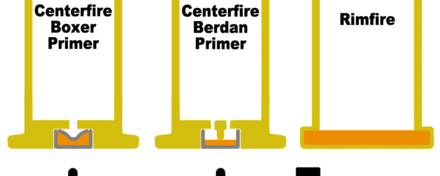
A primer flash hole is simply a tiny hole at the bottom of the primer in the cartridge base that releases the flash or spark from the kindled primer into the propellant territory. This can best be understood by revisiting the above demonstrative GIF images.
Owing to this versatility, centerfire cartridges have generally earned wider applications in the space of firearms, especially for more high-end calibers. Some popular examples of calibers suitable for centerfire ammo are the 9 mm pistol for handguns and 5.56/.223 rifles. Nonetheless, that shouldn’t confine your application.
Where is the Rimfire Ammunition Commonly Applied?
As opposed to centerfire ammunition, rimfire ammunition is popular with smaller calibers. The justification for this is that the cartridge walls or shell for smaller calibers must be lean enough to allow the firing pin to crush them effortlessly in the process of kindling the primer.
Such a delicate casing means you cannot use the rimfire ammunition beyond small calibers. Using it in larger, more powerful calibers would result in cartridge shattering owing to the quantity of powder needed to propel a bigger bullet in such guns.
For that reason, the most popular caliber for rimfire ammunition is the .22 Long Rifle or RF, where most shooting beginners start their range journey.
Which One is the Better Ammunition For You?
Having understood the differences between centerfire and rimfire cartridges, which one would you consider a superior companion to your range endeavors?
To answer that question with surefooted confidence, you should take some time to weigh the pros and cons of each ammunition first. This is a crucial step especially if you boast up to several weapons in your range armory for different shooting needs.
Pros of Using Rimfire Cartridges
Pocket-Friendly
Ideally, the cost of manufacturing a unit of a rimfire cartridge is way lower compared to a centerfire cartridge. This is backed by the simple structure of the rimfire cartridge compared to its counterpart. Its thin casing and flat-based primer underscore the low cost of production while ruling out the possibility of reloading the casing.
Beginner-Friendly
Being confined to lower calibers, rimfire ammunition applies less gunpowder in the shooting process. As a result, less firing recoil arises. This makes the ammo ideal for starter shooters before full mastery of firearm wielding.
Moreover, minimal felt recoil empowers the process of confidence-building in a beginner by eliminating unnecessary flinching while stabilizing target acquisition.
Perfect For Elderly Shooters
The fact that rimfire ammo complements smaller calibers and adopts a lightweight design makes it ideal for elderly shooters with weaker hand strength.
Cons of Using Rimfire Cartridges
Reliability Compromises
The manufacturing process of both the centerfire and rimfire ammunition dictates how much of a reliable performance they can deliver. While centerfire cartridges feature a standalone primer distinct from the casing, the rimfire ammunition integrates the primer into the casing.
Such a primer alignment leaves room for a detached primer from the base rim. The aftermath is a frustrating misfiring or malfunctioning experience with smaller calibers. That means while rimfire rounds make a great practice or training companion, they may not be reliable when it comes to self-defense applications.
In other words, the weak shell casing in a rimfire cartridge means it can handle less pressure. The lesser the pressure, the lesser the kinetic energy exerted hence less power compared to centerfire rounds. Further, that also limits the shooting distance with rimfire rounds.
Confined to Small Calibers
The thin-walled casing design of the rimfire ammunition limits its applications to only smaller calibers. While you may be looking to rake in the price gains in your ammunition purchase, your large caliber firearm may end up suffering a huge setback.
Cannot be Reloaded
If you prefer reloading your ammunition with every couple of rounds fired, the rimfire ammunition may not be for you. Because the primer of the rimfire is spun into the base ring, it loses its significance once fired.
Not Ideal for Long-Distance Shooting
The lower recoil attribute in rimfire rounds improves their accuracy over shorter shooting distances. For long distances, however, that becomes an uphill climb owing to their lightweight nature that is susceptible to wind disruption. If firing beyond 100 yards, for instance, the reliability of centerfire rounds may prove worthy.
Pros of Using Centerfire Cartridges
Reloadable
The primer of centerfire rounds is quite divorced from the cartridge base. That means once fired, the casing doesn’t lose its significance hence can be reloaded.
The reloading advantage opens a door to customize every round in a bid to enhance the round quality and firing accuracy.
Suitable for Long-Distance Shooting
Armed with heavier projectiles, centerfire rounds tend to maneuver outside interference with much ease. This guarantees better accuracy when shooting at long distances.
Versatile Applications
Unlike rimfire rounds, centerfire rounds sit well with different calibers. This makes them suitable for different shooting applications including home defense and big prey hunting. What’s more, both the Boxer primers and Berdan primers come in different standard sizes to enhance versatility.
Cons of Using Centerfire Cartridges
Costly
While centerfire ammunition may prove superior to rimfire ammunition in many respects, the cost exception cannot be overlooked. Thanks to versatility, better materials, and a more intuitive build, the centerfire ammunition is pricier than its counterpart.
Recommended or Not?
A lot of consideration must go into this determination. Narrowing down the pros and cons of each ammunition, it is important to highlight that centerfire ammo affords you more flexibility and value for money.
That means while the rimfire ammunition is cheaper, it cannot be salvaged. However, for centerfire ammunition, salvaging and reloading becomes a profitable reality.
But why does reloading precede price? For a novice shooter, this may not make much sense. Nonetheless, it is something you should always aim for as you level up your shooting game. Reloading becomes a profitable consideration when striving for multiple rounds. Besides convenience, reloading adds an extra layer of accuracy in your range activities because you get to be in control of your load specifications.
With that in mind, the extent of your firearm use also comes into play when settling for the most ideal ammo. If you are a hunter, for instance, small game hunting would yield the best results when firing with rimfire ammunition.
For larger prey, centerfire ammunition might just suffice. Generally crafted from a softer material, rimfire ammo would have a hard time infiltrating the hide of larger prey essentially paving the way for centerfire rounds.
Therefore, depending on your level of shooting skill, application, and how much customization you are after, you might want to determine how much value for money you derive from each functional advantage in both the rimfire and centerfire ammo before settling for either one of them.
Rimfire vs Centerfire – Final Verdict
In conclusion, choosing between centerfire and rimfire cartridges boils down to the niche in question. That said, it doesn’t hurt to have both in case you wield both centerfire and rimfire firearms.
If you are a beginner shooter trying to master your way through firearm use, you might find the rimfire ammunition a conducive addition to your starter pack. Similarly, if you are elderly or would prefer something a little more lightweight, the rimfire round would qualify as the ideal ammo as it is far easier to handle.
On the flip side, if you have perfected your act at the range or amassed solid experience with firearms, you might be better off in the company of centerfire ammunition. Moreover, if you have a habitual knack for reloading your weapon, the centerfire ammo might equally be the ideal round choice.
Beyond performance strength, centerfire ammo also delivers unrivaled versatility, accuracy, and reliability thanks to the firearm-friendly and user-friendly design. Furthermore, as a reloader, you get to save a huge chunk of money over time as you keep your ammo expenditure down.
Rimfire vs Centerfire – whether you have a soft spot for rimfire or centerfire, at the end of the day, value wins! Good luck trying out your newly acquired rounds!

